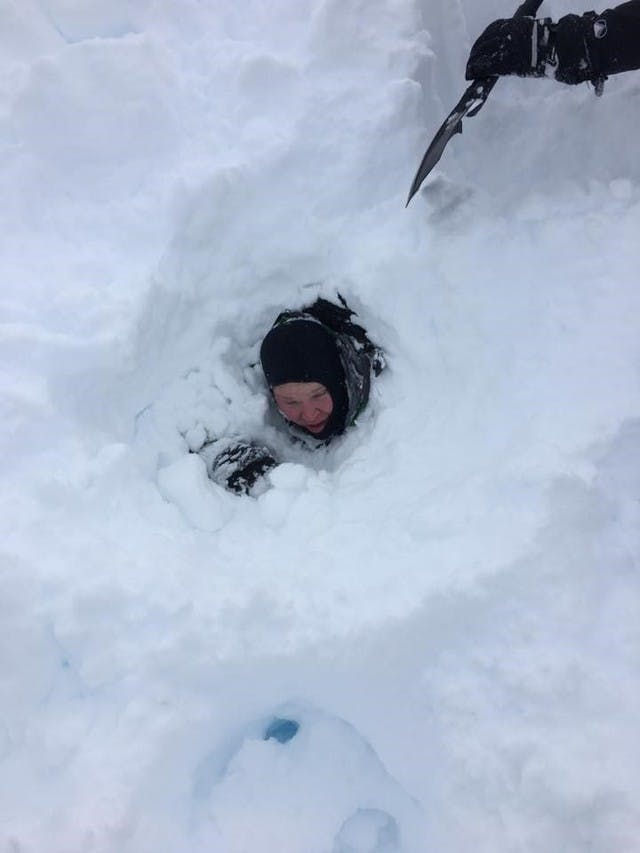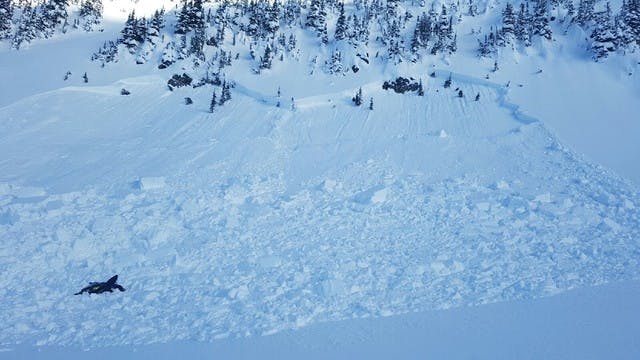- Date
- Tuesday, January 31, 2017
I don't care what you call them, I care about what we do with them.
Notable Avalanche, Near Miss, or Close Call: Honestly, I don’t really care what you call them; my interest is what you do with them. My goal is to learn from recent events and share ideas for improving how you travel in the mountains. On Sunday a group near Smithers had a close call – way too close. Reflecting and learning from a close call morphs it into a Free Gift. Sharing your story allows us all to benefit.

Photo Courtesy of Kaitlyn Lauren Miles Facebook
The areas of greatest concern are:
- Northern Monashees around Blue River & Valemount (e.g. Red Sands through Clemina),
- Cariboos around Blue River, Valemount, and McBride (e.g. Allan Creek to Bear’s Den/Sugar Bowl),
- North Rockies from McBride to Pine Pass (e.g. Renshaw, Torpy, Hassler),
- Northwest Inland near Smithers and Houston (e.g. Telkwa, Microwave-Sinclair, Ashman).
The snowpack in these areas shares the same basic structure: softer, weak layers in the mid-pack that are now buried between 50 and 120 cm by firmer, more cohesive snow. The mid-pack weak layers are either Surface Hoar (feathery crystals), Facets (sugary granules), or a combination of the two. In some areas there’s a similarly weak structure near the ground. Basically, long periods of cold dry weather weakens the existing snowpack. Another rule-of-thumb is shallow snowpack are weaker than deep snowpacks. It’s cold dry winter with relatively little snow in many parts of BC.
Big storms are a source of major, rapid change that shocks the snowpack and cause natural avalanche cycles. Sadly, most of the storms this winter have only delivered moderate punches. The technical term is Incremental Loading. The snowpack receive a minor stress, we see some natural avalanches, and then it all re-adjusts to the new load. Conditions remain primed for avalanches but aren’t at the tipping point. Between storms you aren’t likely to see natural avalanches, forecast danger ratings may drop to Moderate, but if you’re riding in the right (wrong) spot you can trigger a land mine. This kind of low probability but significant problem often lingers for days, weeks, and possibly months.
I have three suggestions for how to deal with this avalanche dragon (that may appear to be snoozing):
- Discipline: vow to avoid certain types of slopes and terrain features and stick to that resolution even with a sled vibrating between your legs, your throttle finger twitches, and you see folks getting away with riding where you’re rational brain said you wouldn’t go.
- Terrain to Avoid: areas with thin or variable snow depth at higher elevations (usually alpine terrain), especially if there are boulders, rocky outcrops, or trees near (and just below) the surface. Areas with thick to thin transitions like cross-loaded slopes are common culprits. “Thin spot trigger” is an important concept. Look at the photos below, most of them show some common traits.
- Good Terrain Choices: small slopes. Even if you’re surprised and trigger a slide the consequences are manageable. This photo was taken by a professional friend, he’s well aware of the conditions, and it was good choice (not chance) that found him playing this small slope. Buried to the waist was all it could do to him!

Photo courtesy of Curtis Pawliuk
Here’s a list of recent avalanches that fit the pattern. Remember, these people didn't go out with the intention of triggering a slide and burying themselves; they were all surprised. I thank them all for sharing their story and giving us Free Gifts.
ilya storm